This article was co-authored by Robert Dhir, MD. Dr. Robert Dhir is a board certified Urologist, Urological Surgeon, and the Founder of HTX Urology in Houston, Texas. With over 10 years of experience, Dr. Dhir’s expertise includes minimally-invasive treatments for enlarged prostate (UroLift), kidney stone disease, surgical management of urological cancers, and men’s health (erectile dysfunction, low testosterone, and infertility). His practice has been named a Center of Excellence for the UroLift procedure, and is a pioneer in non-surgical procedures for ED using his patented Wave Therapy. He earned his undergraduate and medical degrees from Georgetown University and was awarded honors in pre-medical studies, urology, orthopedics, and ophthalmology. Dr. Dhir served as chief resident during his urological surgical residency at University of Texas at Houston / MD Anderson Cancer Center in addition to completing his internship in general surgery. Dr. Dhir was voted Top Doctor in Urology for 2018 to 2019, one of the top three Best Rated Urologists in 2019 & 2020 for Houston Texas, and Texas Monthly has named him to the 2019 & 2020 Texas Super Doctors Rising Stars list.
There are 16 references cited in this article, which can be found at the bottom of the page.
This article has been viewed 137,690 times.
A hydrocele is a buildup of fluid that can occur around one or both testicles. It is normally painless but can cause swelling that can be uncomfortable.[1] The condition is common in newborns and usually goes away on its own. In adults, this can occur because of injury or other scrotal inflammation, but is not usually harmful.[2] There are symptoms that you can look for to identify whether you have a hydrocele.
Steps
Recognizing Symptoms
-
1Look for swelling. Stand in front of the mirror and look at your scrotum. If you have a hydrocele, at least one side of your scrotum will be larger than it normally is.[3]
- If you are trying to determine if an infant is suffering from a hydrocele, the procedure will be similar. Look for swelling in the testicles. The swelling may be on either or both sides of the testicles.
-
2Feel for a hydrocele. Often, a hydrocele will feel like a fluid-filled sac inside the scrotum.[4] Gently grasp your swollen testicle and see if you can feel this balloon-like sac in your scrotum.[5]
- Typically, a hydrocele will not feel painful. If, when touching your scrotum, you experience pain, contact your doctor as it could indicate something more serious.
- If an infant has a swollen testicle, you can identify a hydrocele by gently feeling the scrotum. Inside the scrotum, you will feel the testicle, and if there is a hydrocele, you will feel a second lump that feels like a soft, fluid-filled sac. In infants, this sac could be as small as a peanut.
- Your doctor will do a physical examination and order an ultrasound to diagnose a hydrocele. Your doctor may also perform the flashlight test. If the mass trans-illuminates under exposure to a flashlight, then it is a hydrocele. If it doesn’t then it may be something more serious like a mass or hernia.
Advertisement -
3Pay attention to any difficulty walking that you experience. The more your scrotum swells, the more likely it is that you will have a hard time walking.[6] [7] Men with this issue have described the feeling as a dragging sensation, like something heavy was tied to their testicles. This is because gravity pulls your scrotum down, but because there is fluid in it that wasn’t there for most of your life, it will feel heavier than normal.
- You might also experience this dragging sensation when you stand up after you have been lying or sitting down for a while.
-
4Monitor any increase in swelling as time goes on. If you do not begin treatment for the hydrocele, your scrotum will continue to swell. If this happens, you might find it hard to put on your regular pants, instead opting to wear baggier pants so that no pressure is put on your swollen scrotum.
- If you believe you might have a hydrocele, it is best to have a doctor determine the cause of the problem. Sometimes, a hydrocele is an indication of a hernia, which needs to be treated by a doctor.
-
5Be aware of any pain you feel while urinating. Normally, you won’t feel any pain while urinating if you have a hydrocele. However, if your hydrocele is caused by an infection in the epididymis and testis (which is referred to as epididymal orchitis) you will most likely feel pain when you go to the bathroom. You should talk to a doctor right away if you begin experiencing this pain.[8]
Understanding Hydroceles in Adults
-
1Understand what causes hydroceles in adult men. Men can have hydroceles for many reasons, the three most common of which are inflammation, infection (such as a sexually transmitted infection), or injury to one or both of their testicles. It can also be caused by injury or infection in the epididymis (a coil-like tube at the back of the testicles which is responsible for the maturation, storage and transport of sperm).[9]
- Sometimes, a hydrocele can also be formed if your tunica vaginalis (the membrane-like covering that covers your testes) collects too much fluid without being able to get rid of it.
- To differentiate hydrocele from other testicular pathology, such as testicular cancer or hernia, shine a flashlight on the scrotum and see if the scrotum transilluminates (allows light to pass through the mass). To do this, dim the lights and shine a bright flashlight at the scrotum.[10] If the scrotum transilluminates, then the mass is a hydrocele.
-
2Be aware that hernias can cause hydroceles. A hernia can cause a hydrocele. However, this form of hydrocele generally presents itself as swelling higher up in the scrotum. To put it in perspective, this sort of swelling is about 2 to 4 centimeter (0.8 to 1.6 in) from the base of the scrotum.[11]
- A hernia occurs when an organ protrudes through the tissue that normally contains it.[12] In the case of a hydrocele, it is not uncommon for a piece of the intestine to protrude through the abdominal wall into the scrotum and is known as an inguinal hernia.
-
3Know that filariasis can cause a type of hydrocele. Filariasis is a tropical disease that is caused by filarial worms get into a person’s lymph vessels. These worms are also the cause of elephantiasis. Instead of abdomen fluid, these worms cause a hydrocele to form that is actually filled with cholesterol and can be referred to as a chylocele.[13]
- If you live in the United States and have never visited Asia, Africa, a Western Pacific Island or any part of the Caribbean or South American, then you do not need to worry about this. However, if you live in any of these places or have spent time in these areas prior to your hydrocele development, you should visit a doctor as soon as possible.
-
4Visit a doctor. If you have a hydrocele, it is generally best to visit a doctor because a hydrocele could indicate more serious problems.[14] [15]
- Before your appointment, write down any recent injuries around the genital area that have occurred, any symptoms you have had (e.g. pain or difficulty walking), any medications you are taking, any inflammatory conditions of the scrotum, and when the hydrocele appeared.
Understanding Hydroceles in Newborns
-
1Understand the normal development of a newborn’s testicles. In order to understand what is happening to your newborn, it's generally important to understand the normal process so you can figure out what went wrong. Testicles develop in a fetus’s abdomen, very close to the kidneys, which later descend into the scrotum through a tunnel known as the inguinal canal. When the testicles descend, they are preceded by a sac that’s formed from the lining of the abdomen (this is called the processus vaginalis).[16] [17]
- The processus vaginalis normally closes above the testicles, which prevents fluid from entering. If it doesn’t close properly, a hydrocele can form.
- Hydroceles result from a reaction to testicular torsion, epididymitis, orchitis, or trauma. These conditions are ruled out by physical examination and ultrasound.
-
2Be aware that your child might have a communicating hydrocele. A communicating hydrocele means that the sac around the testicles (the process vaginalis) remains open, rather than closing up like it's supposed to. When it remains open, it allows fluid to get into the scrotum, creating the hydrocele.[18]
- While the sac remains open, fluid can flow back and forth from the abdomen to the scrotum which means that the size of the scrotum will get larger and smaller throughout the day.
-
3Know that your child could also have a non-communicating hydrocele. A non-communicating hydrocele forms when the testicles descend as they should with the sac (the processus vaginalis) closing up around them. However, the fluid that goes into the sac with the testicles doesn’t get absorbed by your child’s body, so it gets trapped in the scrotum and forms a hydrocele.[19]
- This type of hydrocele usually disappears within the first year of a child’s life. However, in an older child, it could indicate a more serious problem, and should be seen by a doctor. If your child was born with a non-communicating hydrocele that doesn’t disappear within one year, ask your child’s doctor to check the hydrocele again.
-
4Talk to the infant’s doctor or pediatrician. Although it is usually nothing to worry about, if an infant has a hydrocele that your doctor has not already addressed, you should talk to them about the hydrocele, especially if the baby is over one year old. This is because it could indicate a more serious problem.[20]
- Take note of when you first noticed the hydrocele, whether or not the child is experiencing any pain, and anything else that could be related to the hydrocele.
- A majority of the hydroceles resolve in newborns by one year of age. Surgical intervention is warranted in those that do not resolve after one year, those that are communicating hydroceles, and those that are idiopathic hydroceles that are symptomatic.
Expert Q&A
Did you know you can get expert answers for this article?
Unlock expert answers by supporting wikiHow
-
QuestionHow can I tell if I have a hydrocele?
 Robert Dhir, MDDr. Robert Dhir is a board certified Urologist, Urological Surgeon, and the Founder of HTX Urology in Houston, Texas. With over 10 years of experience, Dr. Dhir’s expertise includes minimally-invasive treatments for enlarged prostate (UroLift), kidney stone disease, surgical management of urological cancers, and men’s health (erectile dysfunction, low testosterone, and infertility). His practice has been named a Center of Excellence for the UroLift procedure, and is a pioneer in non-surgical procedures for ED using his patented Wave Therapy. He earned his undergraduate and medical degrees from Georgetown University and was awarded honors in pre-medical studies, urology, orthopedics, and ophthalmology. Dr. Dhir served as chief resident during his urological surgical residency at University of Texas at Houston / MD Anderson Cancer Center in addition to completing his internship in general surgery. Dr. Dhir was voted Top Doctor in Urology for 2018 to 2019, one of the top three Best Rated Urologists in 2019 & 2020 for Houston Texas, and Texas Monthly has named him to the 2019 & 2020 Texas Super Doctors Rising Stars list.
Robert Dhir, MDDr. Robert Dhir is a board certified Urologist, Urological Surgeon, and the Founder of HTX Urology in Houston, Texas. With over 10 years of experience, Dr. Dhir’s expertise includes minimally-invasive treatments for enlarged prostate (UroLift), kidney stone disease, surgical management of urological cancers, and men’s health (erectile dysfunction, low testosterone, and infertility). His practice has been named a Center of Excellence for the UroLift procedure, and is a pioneer in non-surgical procedures for ED using his patented Wave Therapy. He earned his undergraduate and medical degrees from Georgetown University and was awarded honors in pre-medical studies, urology, orthopedics, and ophthalmology. Dr. Dhir served as chief resident during his urological surgical residency at University of Texas at Houston / MD Anderson Cancer Center in addition to completing his internship in general surgery. Dr. Dhir was voted Top Doctor in Urology for 2018 to 2019, one of the top three Best Rated Urologists in 2019 & 2020 for Houston Texas, and Texas Monthly has named him to the 2019 & 2020 Texas Super Doctors Rising Stars list.
Board Certified Urologist & Urological Surgeon
-
QuestionHow does hydrocele feel?
 Robert Dhir, MDDr. Robert Dhir is a board certified Urologist, Urological Surgeon, and the Founder of HTX Urology in Houston, Texas. With over 10 years of experience, Dr. Dhir’s expertise includes minimally-invasive treatments for enlarged prostate (UroLift), kidney stone disease, surgical management of urological cancers, and men’s health (erectile dysfunction, low testosterone, and infertility). His practice has been named a Center of Excellence for the UroLift procedure, and is a pioneer in non-surgical procedures for ED using his patented Wave Therapy. He earned his undergraduate and medical degrees from Georgetown University and was awarded honors in pre-medical studies, urology, orthopedics, and ophthalmology. Dr. Dhir served as chief resident during his urological surgical residency at University of Texas at Houston / MD Anderson Cancer Center in addition to completing his internship in general surgery. Dr. Dhir was voted Top Doctor in Urology for 2018 to 2019, one of the top three Best Rated Urologists in 2019 & 2020 for Houston Texas, and Texas Monthly has named him to the 2019 & 2020 Texas Super Doctors Rising Stars list.
Robert Dhir, MDDr. Robert Dhir is a board certified Urologist, Urological Surgeon, and the Founder of HTX Urology in Houston, Texas. With over 10 years of experience, Dr. Dhir’s expertise includes minimally-invasive treatments for enlarged prostate (UroLift), kidney stone disease, surgical management of urological cancers, and men’s health (erectile dysfunction, low testosterone, and infertility). His practice has been named a Center of Excellence for the UroLift procedure, and is a pioneer in non-surgical procedures for ED using his patented Wave Therapy. He earned his undergraduate and medical degrees from Georgetown University and was awarded honors in pre-medical studies, urology, orthopedics, and ophthalmology. Dr. Dhir served as chief resident during his urological surgical residency at University of Texas at Houston / MD Anderson Cancer Center in addition to completing his internship in general surgery. Dr. Dhir was voted Top Doctor in Urology for 2018 to 2019, one of the top three Best Rated Urologists in 2019 & 2020 for Houston Texas, and Texas Monthly has named him to the 2019 & 2020 Texas Super Doctors Rising Stars list.
Board Certified Urologist & Urological Surgeon
Warnings
- Long standing hydrocele can calcify, which means it will become rock-like in consistency.⧼thumbs_response⧽
- While this condition is generally painless, it is best to have the hydrocele examined by a doctor to rule out any dangerous causes of the hydrocele.⧼thumbs_response⧽
- Sexually transmitted infections (STIs) can also cause hydroceles. If you have a hydrocele and have had unprotected sex, be sure to rule out this possible cause.[22]⧼thumbs_response⧽
References
- ↑ Robert Dhir, MD. Board Certified Urologist & Urological Surgeon. Expert Interview. 23 September 2020.
- ↑ https://my.clevelandclinic.org/health/diseases/16294-hydrocele
- ↑ https://medlineplus.gov/ency/article/000518.htm
- ↑ Robert Dhir, MD. Board Certified Urologist & Urological Surgeon. Expert Interview. 23 September 2020.
- ↑ https://patient.info/mens-health/scrotal-lumps-pain-and-swelling/hydrocele-in-adults
- ↑ Robert Dhir, MD. Board Certified Urologist & Urological Surgeon. Expert Interview. 23 September 2020.
- ↑ https://patient.info/mens-health/scrotal-lumps-pain-and-swelling/hydrocele-in-adults
- ↑ http://patient.info/doctor/epididymo-orchitis-pro
- ↑ http://www.mayoclinic.org/diseases-conditions/hydrocele/basics/causes/con-20024139
- ↑ https://medlineplus.gov/ency/article/003389.htm
- ↑ https://www.ncbi.nlm.nih.gov/books/NBK559125/
- ↑ http://my.clevelandclinic.org/health/diseases_conditions/hic-hernia
- ↑ http://www.cdc.gov/parasites/lymphaticfilariasis/gen_info/faqs.html
- ↑ Robert Dhir, MD. Board Certified Urologist & Urological Surgeon. Expert Interview. 23 September 2020.
- ↑ http://www.mayoclinic.org/diseases-conditions/hydrocele/basics/preparing-for-your-appointment/con-20024139
- ↑ http://www.urologyhealth.org/urologic-conditions/hydroceles-and-inguinal-hernia/causes
- ↑ http://www.merriam-webster.com/medical/processus%20vaginalis
- ↑ http://www.stanfordchildrens.org/en/topic/default?id=hydrocele-90-P03090
- ↑ http://www.stanfordchildrens.org/en/topic/default?id=hydrocele-90-P03090
- ↑ http://www.mayoclinic.org/diseases-conditions/hydrocele/basics/preparing-for-your-appointment/con-20024139
- ↑ https://urology.ucsf.edu/patient-care/children/genital-anomalies/hydrocele-and-hernia
- ↑ http://www.mayoclinic.org/diseases-conditions/hydrocele/basics/risk-factors/con-20024139
About This Article
A hydrocele is a build up of fluid that can occur in one or both of your testicles. You’ll know you have a hydrocele if you have swelling inside your testicles. It may also feel heavy and a little uncomfortable while you walk. Hydroceles are usually a result of inflammation, infection, or injury to one or both of your testicles. In some cases, you may experience pain while urinating. If you think you have a hydrocele, visit a doctor as soon as possible so they can rule out underlying conditions. For more tips from our Medical co-author, including how to treat hydroceles in new-born babies, read on.


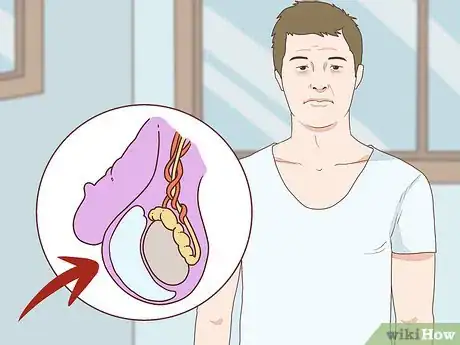
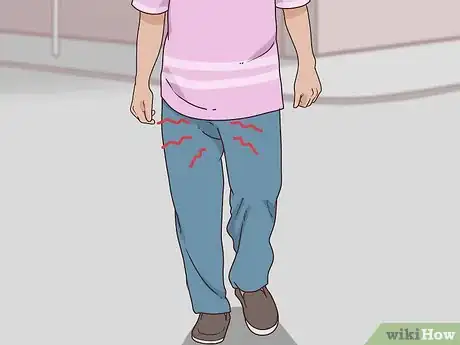
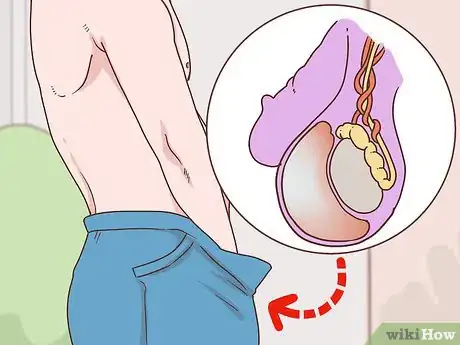
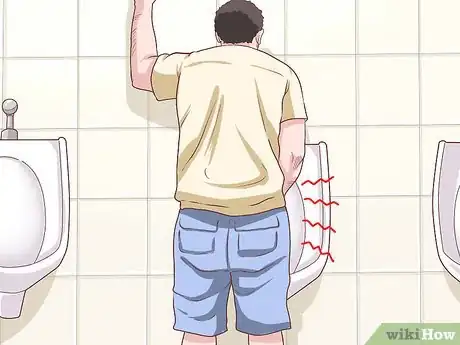
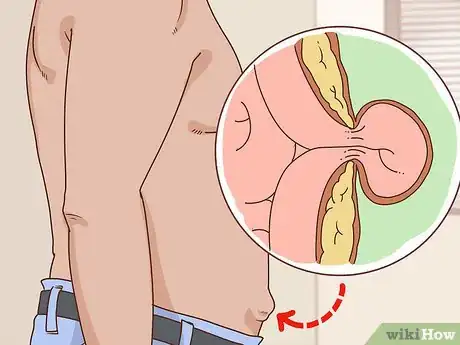
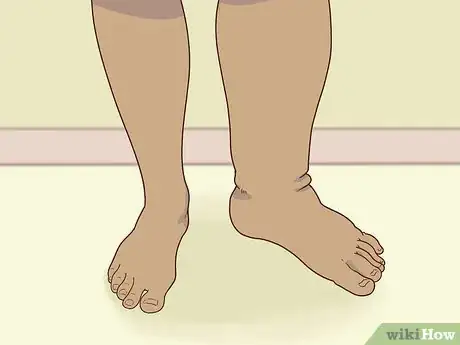

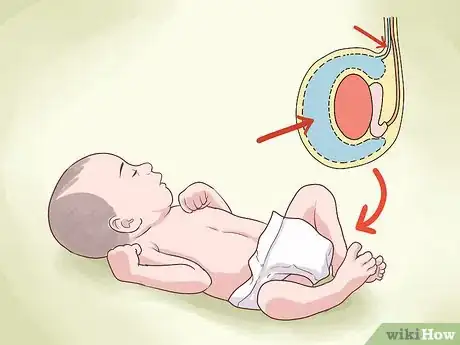
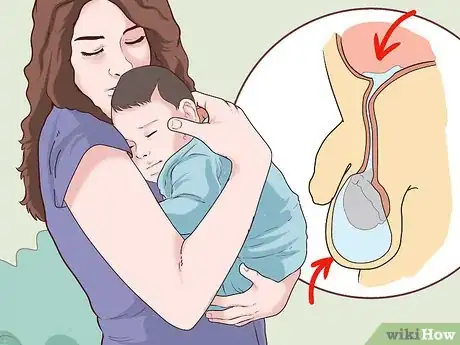
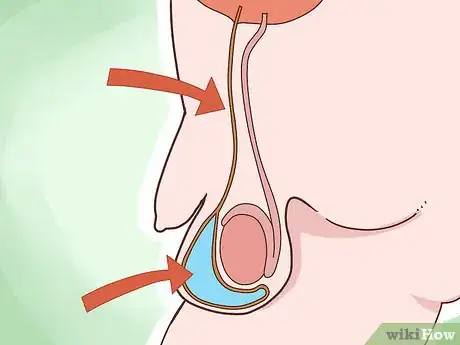

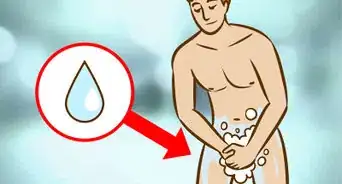
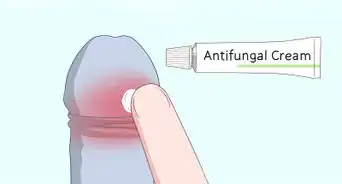
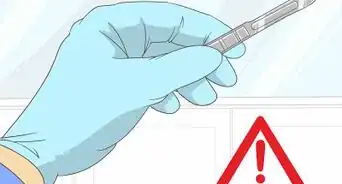



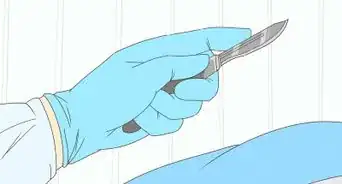




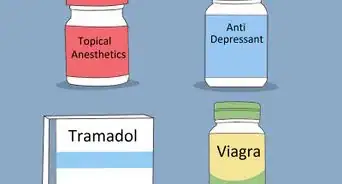

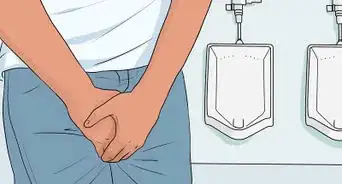







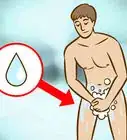
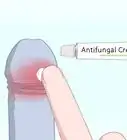

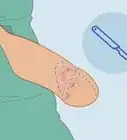



































Medical Disclaimer
The content of this article is not intended to be a substitute for professional medical advice, examination, diagnosis, or treatment. You should always contact your doctor or other qualified healthcare professional before starting, changing, or stopping any kind of health treatment.
Read More...